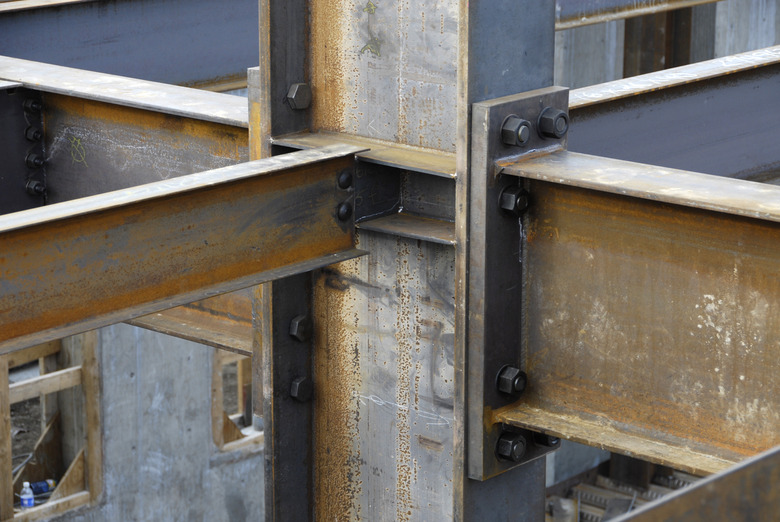How To Calculate A Steel I-Beam's Weight
Consider calculating the weight of a steel I-beam before overloading a structure. Steel I-beam's are too large and heavy for a conventional scale, but their weight can be determined mathematically with a few measurements. The weight of a steel beam depends on its volume and the weight density of steel. Volume depends on the dimensions of the beam and determines how much space it occupies. Weight density measures the number of pounds a cubic foot of a substance weighs. For standard construction steel, the weight density is about 490 pounds per cubic foot.
Measuring an I-Beam
Measuring an I-Beam
A steel I-beam's shape consists of three solid, rectangular pieces welded together. Each of these must be measured to determine the I-beam's volume.
First, measure the length of the steel I-beam in inches. For example, the length may be 130 inches.
Second, measure the thickness and width of the top and bottom portions of the I-beam in inches. Make the measurement from the side of the beam that looks like an "I." These thicknesses and widths are usually the same. For example, assume that the top and bottom parts of the I-beam may both have a thickness of 2 inches and a width of 10 inches.
Third, measure the height and thickness of the central portion of the I-beam in inches. Make the measurement from the side of the beam that looks like an "I." For example, the thickness may be 3 inches, while the height may be 15 inches.
Calculating Volume and Weight
Calculating Volume and Weight
First, multiply the thickness times height times length for the central part of the I-beam to get its volume in cubic inches. Performing this step for example used above leads to 3 inches times 15 inches times 130 inches, or 5,850 cubic inches.
Secondly, multiply the thickness times width times length for the top and bottom parts of the I-beam separately in order to obtain the volume of each in cubic inches. In the example, this step yields 2 inches times 10 inches times 130 inches, or a volume of 2,600 cubic inches for each part.
Thirdly, add the volume of the three parts of the I-beam to obtain the total volume in cubic inches. Continuing the exercise, you have 5,850 cubic inches plus 2,600 cubic inches plus 2,600 cubic inches, or 11,050 cubic inches.
Fourthly, convert the volume to cubic feet by dividing by 1,728, since a cubic foot equals 1,728 cubic inches. For example, this calculation leads to 11,050 cubic inches divided by 1,728 cubic inches per cubic foot, or a volume of 6.4 cubic feet.
Finally, multiply the weight density of steel, in pounds per cubic foot, by the volume to get the weight of the I-beam in pounds. Completing the exercise leads to 490 pounds per cubic foot times 6.4 cubic feet, or a weight of 3,136 lb.
Cite This Article
MLA
Hirsch, William. "How To Calculate A Steel I-Beam's Weight" sciencing.com, https://www.sciencing.com/calculate-steel-ibeams-weight-8116040/. 13 March 2018.
APA
Hirsch, William. (2018, March 13). How To Calculate A Steel I-Beam's Weight. sciencing.com. Retrieved from https://www.sciencing.com/calculate-steel-ibeams-weight-8116040/
Chicago
Hirsch, William. How To Calculate A Steel I-Beam's Weight last modified August 30, 2022. https://www.sciencing.com/calculate-steel-ibeams-weight-8116040/
